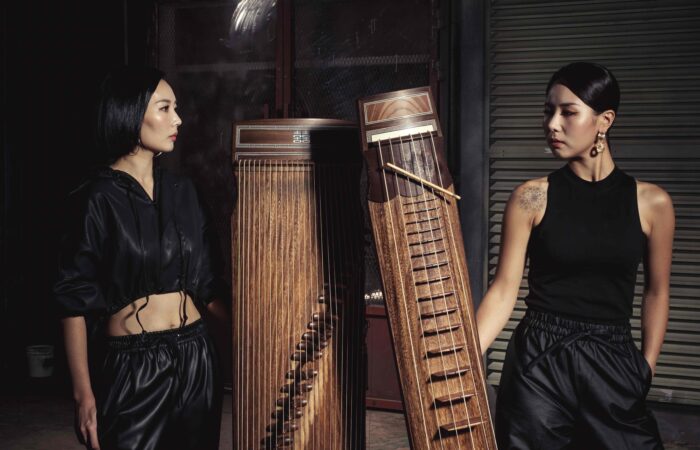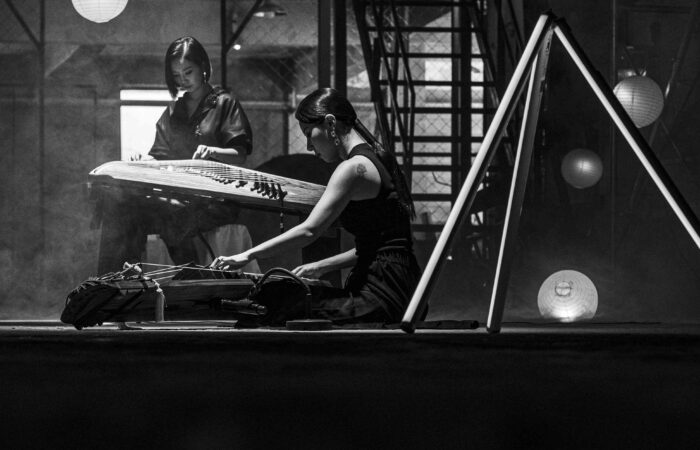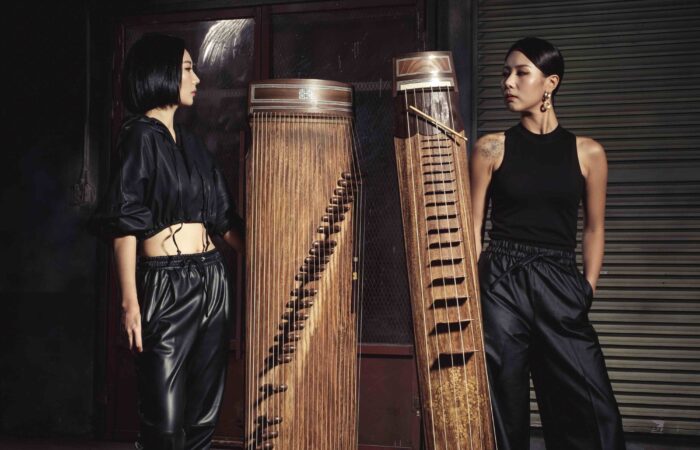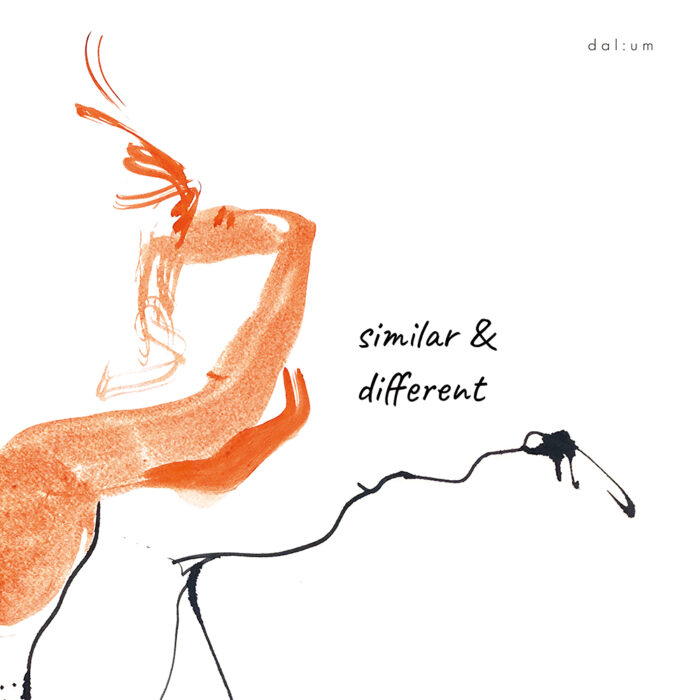Due musicisti. Due pesanti strumenti a corda acustici. Un dialogo tra pratiche tradizionali e sperimentali. Una fusione di nuove possibilità e risonanze profondamente percorse.
Dal:um nasce nel 2018 da Ha Suyean (gayageum) e Hwang Hyeyoung (geomungo). Suyean osserva che si sono incontrate per la prima volta “come membri del Seoul Metropolitan Youth Traditional Music Ensemble di cui facciamo ancora parte. Entrambe abbiamo riflettuto ed esplorato le possibilità dei nostri rispettivi strumenti a corda e questo ci ha portato a unirci come una squadra”. Sebbene sia Suyean che Hyeyoung suonassero musica tradizionale coreana sin dalla loro infanzia, incontrandosi scoprirono il desiderio condiviso di estendere le tecniche e i confini dei loro strumenti e di sviluppare il proprio repertorio distintivo. La musica di Dal:um ne è il risultato.
“Il significato letterale di Dal:um è ‘continuare a perseguire qualcosa’ e trasmette la nostra passione per la musica”, dice Hyeyoung. “In coreano la sua pronuncia potrebbe anche significare ‘diverso’. Dal:um rappresenta i suoni di due strumenti simili e diversi – geomungo e gayageum, e la nostra volontà di continuare a perseguire dialoghi musicali tra noi due”.
Quando vengono messi in piano per l’esecuzione, i due strumenti suonati da Dal:um sembrano essere abbastanza simili. Tuttavia, un esame più attento rivela individualità sia visive che sonore.
Nella foto, Suyean (a sinistra) tiene in mano il gayageum e Hyeyoung (a destra) il geomungo. Questi strumenti sono di origine antica, hanno corde di seta che vengono pizzicate e possono emettere sia tonalità melodiche che risonanze percussive. Ma la loro differenza di dimensioni, oltre al fatto che hanno un diverso numero di corde, conferisce a ciascuna di esse un carattere musicale distintivo. Infatti, come indica il titolo dell’album, il gayageum e il geomungo sono entrambi “simili e diversi”.
Il titolo dell’album di Dal:um però non è solo una dichiarazione descrittiva. Funziona anche come credo per il concetto musicale del duo. Si riflette negli strumenti che suonano, nei loro background musicali individuali e nella loro ricerca comune di nuovi suoni e visioni.
Suyean riassume il suo viaggio musicale in questo modo: “Ho iniziato a suonare il gayageum quando avevo nove anni e quando ho raggiunto i vent’anni, volevo raccontare le mie storie con il mio strumento. Sono desiderosa di esprimere emozioni complicate che non possono essere espresse completamente con le parole. Ho iniziato a svelare quelle emozioni parlando con Hyeyoung. La storia e l’ethos musicale di Hyeyoung condividono elementi con quelli di Suyean, ma ovviamente vira in una direzione personale. Racconta: “Ho iniziato con il gayageum all’età di otto anni, per poi passare al geomungo a tredici. Da allora, continuo a creare versioni di “me stessa”. Suonavo musica tradizionale, ma un giorno ero incuriosita dall’idea di creare la mia musica e quella è diventata la mia passione. Ora, ho lavorato a varie storie come Dal:um con Suyean”.
C’è un minimalismo raffinato e paziente nelle composizioni e nell’espressione musicale di Dal:um. In parte questo può essere attribuito alla loro profonda ricerca sulla composizione contemporanea. Il duo osserva specificamente che “questo album contiene i risultati del dialogo sulla nostra musica con tre giovani compositori coreani: Jang Taepeyong, Choi Jiwoon e Lee Aro”.
La musica di Dal:um potrebbe anche essere vista come una condivisione di interessi estetici con la pittura tradizionale asiatica e il suo intrinseco dialogo (e armonia) tra vuoto e pieno. Tale pittura è una forma rarefatta dove ciò che viene tralasciato diventa spesso l’elemento chiave dell’opera.
L’album di debutto del duo sembra iniziare con una pausa. Un breve silenzio che cede ai leggeri colpi di campana e ai suoni ripetitivi prodotti dai colpetti contro il legno dei loro strumenti. Le prime pizzicate delle corde di seta del gayageum e del geomungo sono sostenute e spaziose mentre la composizione si evolve lentamente e con grazia.
“La musica di Dal:um viene dal ‘vuoto'”, dice Hyeyoung. “Abbiamo lavorato per creare un equilibrio tra il suono originale delle corde di seta e la bellezza del vuoto. È facile essere ossessionati dal riempire gli spazi vuoti quando si vuole esprimere qualcosa, quindi cerchiamo sempre di non riempire le cose in modo avventato. Ci stiamo concentrando sulla bellezza dei suoni e dei toni puri del gayageum e del geomungo per trasformare il “vuoto” in uno spazio di anticipazione”.
Suyean continua: “Il fascino della musica di Dal:um deriva dai suoi vuoti naturali, non dal frettoloso riempimento di note musicali. Il fascino deriva dal trasmettere i sentimenti all’interno di questi vuoti.
La musica meravigliosamente bilanciata ed espansiva di Dal:um è definita da dialoghi ispirati e paradossi creativi.
Silenzio ed espressione.
Contemporaneo e tradizionale.
Pieni e vuoti.
Simili e diversi.
English
Two musicians. Two weighty acoustic stringed instruments. A dialogue between traditional and experimental practices. A melding of both new possibilities and deeply travelled resonances.
Dal:um was founded in 2018 by Ha Suyean (gayageum) and Hwang Hyeyoung (geomungo). Suyean notes that they first met “as members of Seoul Metropolitan Youth Traditional Music Ensemble which we still are in. We both had been pondering and exploring the possibilities of our respective string instruments, and that led us to come together as a team.” While both Suyean and Hyeyoung had been performing Korean traditional music since their childhoods, upon meeting they discovered a shared desire to extend the techniques and boundaries of their instruments and to develop their own distinctive repertoire. The music of Dal:um is the result.
“Dal:um’s literal meaning is ‘keep pursuing something’ and it conveys our passion for music” says Hyeyoung. “In Korean its pronunciation could also mean ‘different’. Dal:um represents the sounds of two similar and different instruments – geomungo and gayageum, and our will to keep pursuing musical dialogues between the two of us.”
When laid flat for performance, the two instruments played by Dal:um appear to be quite similar.
However, a closer examination reveals both visual and sonic individualities.
These instruments are ancient in origin, have silk strings that are plucked and can emit both melodic tonalities and percussive resonances. But their size difference, as well as the fact that they have a different number of strings, gives each of them a distinctive musical character. Indeed, as the album title indicates, the gayageum and the geomungo are both “similar & different.”
Dal:um’s album title though is not merely a descriptive statement. It also functions as a credo for the duo’s musical concept and conversation. It is reflected in the instruments that they play, in their individual musical backgrounds and in their collective search for new sounds and visions.
Suyean encapsulates her musical journey this way: “I started playing the gayageum when I was nine and when I entered my twenties, I wanted to tell my own stories with my instrument. I’m eager to express complicated emotions that cannot be fully said with words with music. I began unfolding those emotions by talking to Hyeyoung.”
Hyeyoung’s story and musical ethos shares elements with Suyean’s but of course veers in its own direction. She tells us, “at first, I started with the gayageum at age eight, and then turned to geomungo at thirteen. Since then, I am continuously creating versions of ‘myself.’ I used to play traditional music for a while, but one day I was intrigued to create my own music and that became my passion. Now, I’ve been working on various stories as Dal:um with Suyean.”
There is a refined and patient minimalism in Dal:um’s compositions and musical expression. In part this can be attributed to their deep investigation of contemporary composition. The duo specifically notes that “this album contains the results of conversations about our music with three young Korean composers: Jang Taepeyong, Choi Jiwoon and Lee Aro.”
Dal:um’s music could also be seen as sharing aesthetic concerns with Asian traditional painting and its inherent dialogue (and harmony) between emptiness and fullness. Such painting is a rarefied form where what is left out, often becomes the key element of the work.
The duo’s debut album seems to begin with a pause. A short silence that yields to soft strikes of a bell and repetitive sounds made by tapping against the wood of their instruments. The first plucks of the silk strings of the gayageum and geomungo are sustained and spacious as the composition unfolds slowly and gracefully.
“Dal:um’s music comes from ‘emptiness’” says Hyeyoung. “We’ve been working to create a balance between the original sound of silk strings and the beauty of emptiness. It’s easy to get obsessed with filling blank spaces when one wants to express something, so we always try not to fill things in rashly. We are focusing on the beauty of the pure sounds and tones of the gayageum and geomungo in order to change ‘blankness’ into a space of anticipation.”
Suyean continues the thought: “the charm of Dal:um’s music comes from its natural gaps, not the hasty filling in of musical notes. The charm comes from conveying the sentiments inside these gaps.”
Dal:um’s beautifully balanced and expansive music is defined by inspired dialogue and creative paradox.
Silence and expression.
Contemporary and traditional.
Fullness and emptiness.
Similar and different.





